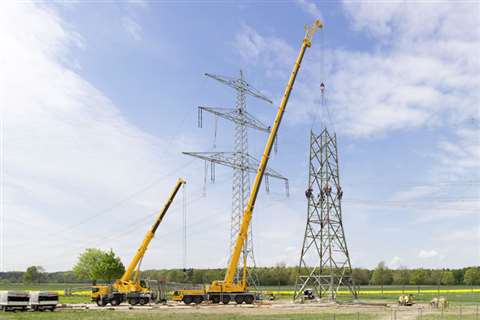Crane industry responds to “unworkable” new EU regulations
15 August 2022
 Designing cranes to help prevent them from coming into contact with live overhead electrical power lines is a controversial part of proposed EU Machinery Regulations. Photo: Liebherr
Designing cranes to help prevent them from coming into contact with live overhead electrical power lines is a controversial part of proposed EU Machinery Regulations. Photo: Liebherr
Crane manufacturers and rental companies have reacted with disbelief to a clause in the draft new European Machinery Regulations that requires all mobile machinery to be designed to prevent contact with overhead power lines – or where the risk cannot be avoided – designed to ensure that all hazards “of an electrical nature” are prevented.
Industry experts said such requirements are impossible to deliver.
When finally agreed, the European Machinery Regulations will update the existing Machinery Directive from 2006.*
This is one of the main pieces of legislation governing the harmonisation of health and safety requirements for machinery throughout the EU and is intended to promote the free movement of machinery within the single market as well as ensuring a high level of protection for workers and the public.
The new disagreement concerns a proposal hidden away in the depths of the regulations – to be precise in Annex III, Part 3, point 3.5.4.
The current version of the regulations states: “When the risk of contact or electric arc with an energised overhead power line to the persons operating machinery incurred by the contact cannot be fully avoided, mobile machinery or related product shall be designed and constructed so as to prevent any electrical hazards in the event of contact with an energised power line.
Klaus Meissner, chairman of CEN TC147/WG11 – the committee responsible for the EN13000 product safety standard for mobile cranes – said, “Neither remote control of mobile cranes, their isolation, nor grounding of the equipment as a whole can prevent all hazards when contacting electrical power lines or arcing.
“Using the cabin as shelter would require blocking the doors in case of contact to power lines or arcing, which in itself bears the risk that persons could not leave the cabin in case of subsequent fire.”
Serious issue
As currently drafted, the regulations would effectively forbid the production or import of any new cranes or mobile machinery as no technical solutions exist that would allow the regulations’ requirements to be met.
The manufacturers and their customers have both pointed out that cranes, aerial work platforms and other types of mobile machinery have to reach heights beyond the height of any power line to do the tasks for which they are intended.
To achieve what they are designed to do, the structure of such cranes must be made of metal – and metal conducts electricity.
Markus Golder, overall chair of CEN/TC 147 – the safety standards committee of the European Committee for Standardisation for all types of crane – said, “It is not possible to design such a crane to prevent the risk of contact with an energised overhead power line.
“There are no systems available that can reliably detect live power lines, and therefore such cranes cannot be ‘constructed and equipped in such a way that all hazards of an electrical nature are prevented’, as the regulations require.”
Golder, who is a Professor at the Faculty for Mechanical Engineering at Chemnitz University of Technology in Germany, continued, “As there is no technical solution available that can reduce this risk, avoiding contact with overhead power lines, it is an organisational issue and the employer’s responsibility under the Use of Work Equipment Directive (UWED).”
He has asked that the relevant section be deleted from the draft regulations, adding that the potential impact of such a regulation would be enormous and would affect the performance of many important tasks, such the erection or maintenance of wind power turbines and railway construction.
The crane manufacturers’ stance was wholeheartedly supported by Ton Klijn, director at the European Association of Abnormal Road Transport and Mobile Cranes (ESTA).
Absurd and completely unworkable
Klijn said, “This proposal is clearly absurd and completely unworkable. What is disappointing is that this problem could have easily been averted if only the relevant authorities had properly consulted the industry in the first place, something that would have saved a lot of time and trouble.
“As it is, such impractical proposals just bring the Commission into disrepute.”
Klijn agreed with Professor Golder that the way to improve safety is through effective and professional management, common standards and high-quality training – not by making impossible demands on the equipment manufacturers and their clients.
A newly drafted study by FEM – the European Materials Handling Federation – that looked afresh at the debate concluded, “A potential contact to energised power lines by mobile cranes (structure of the crane, the hoist rope and-or the lifted load) cannot be avoided by inherent design of the structure due to the purpose of the equipment.”
The European Commission has been asked for comment.
* To explain the change from Directive to Regulations the European Commission proposal states the following:
“The proposed change from a Directive to a Regulation takes into account the Commission’s general objective to simplify the regulatory environment and the need to ensure a uniform implementation throughout the Union of the proposed legislation.
“In addition, the machinery directive is a total harmonisation directive, which means that it establishes a high level of safety, and does not allow the Member States to impose more restrictive obligations. In this respect, a Regulation by its legal nature, would better ensure that Member States do not impose national technical requirements that go beyond the safety requirements laid down in Annex I of the current Directive and-or contradict those safety requirements.”
STAY CONNECTED



Receive the information you need when you need it through our world-leading magazines, newsletters and daily briefings.
CONNECT WITH THE TEAM








